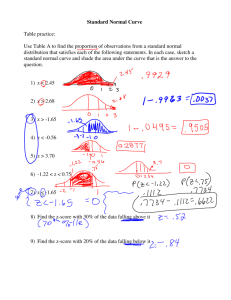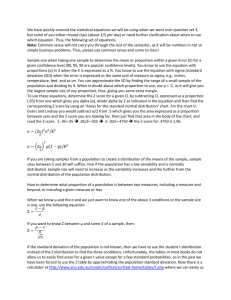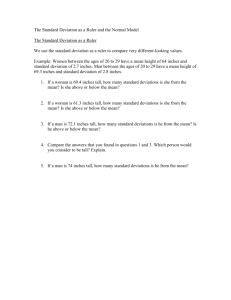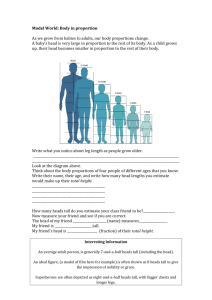Chapter 3: The Normal Distribution
advertisement
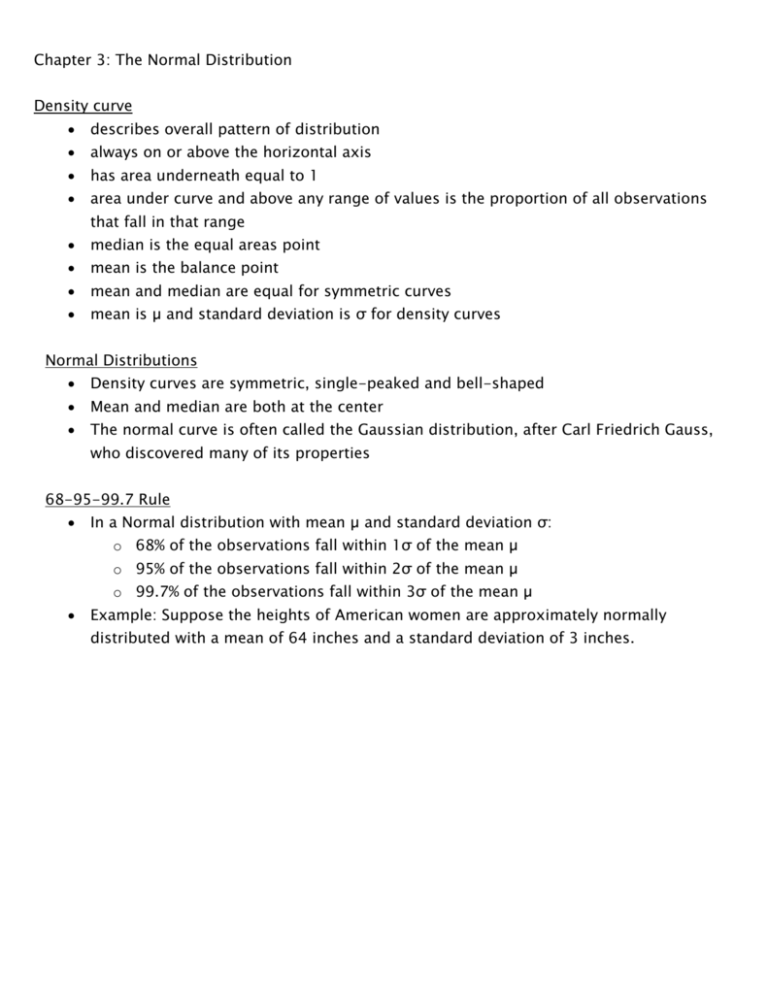
Chapter 3: The Normal Distribution Density curve describes overall pattern of distribution always on or above the horizontal axis has area underneath equal to 1 area under curve and above any range of values is the proportion of all observations that fall in that range median is the equal areas point mean is the balance point mean and median are equal for symmetric curves mean is µ and standard deviation is σ for density curves Normal Distributions Density curves are symmetric, single-peaked and bell-shaped Mean and median are both at the center The normal curve is often called the Gaussian distribution, after Carl Friedrich Gauss, who discovered many of its properties 68-95-99.7 Rule In a Normal distribution with mean µ and standard deviation σ: o 68% of the observations fall within 1σ of the mean µ o 95% of the observations fall within 2σ of the mean µ o 99.7% of the observations fall within 3σ of the mean µ Example: Suppose the heights of American women are approximately normally distributed with a mean of 64 inches and a standard deviation of 3 inches. Standardizing Scores If x is an observation from a distribution with a mean of µ and a standard deviation of σ, the standardized value of x (also known as a z score) is x z The z score tells us how many standard deviations from the mean that a value is and in which direction. Table A in your text gives areas less than z. Example: Refer back to the last example. A. What proportion of women at more than six feet tall? B. What proportion of women are less than 68 inches tall? C. What proportion of women are less than five feet tall? D. What proportion of women are between 55 and 63 inches tall? E. What proportion of women are between 55 and 68 inches tall? “Backward” Normal Calculations x Recall z is used to convert an x value to a z-score x z is used to convert a z-score to an x value Example: Suppose the heights of American women are distributed N(64,3). A. How tall does a woman have to be to be in the tallest 5%? B. How tall does a woman have to be to be in the shortest 10%? C. What heights will contain the middle 50% of the values? Some Problems 1. In designing seats to be installed in commercial aircrafts, engineers want to make the seats wide enough to fit 98% of all males (Accommodating 100% of all males would require very wide seats that would be much too expensive.) Men have hip breadths that are normally distributed with a mean of 14.4 inches and a standard deviation of 1.0 in (based on anthropometric survey from Gordon, Clauser, et al.) How wide should they make the seats? 2. Replacement times for TV sets are normally distributed with a mean of 8.2 years and a standard deviation of 1.1 years (Based on data from “Getting Things Fixed”, Consumer Reports). A. What proportion of TV sets will have a replacement time of less than 5.0 years? B. What proportion of TV sets will have a replacement time of more than 10.0 years? C. What proportion of TV sets will have a replacement time of between 8 and 9 years? D. If you want to provide a warranty so that only 1% of the TV sets will be replaced before the warranty expires, what is the time length of the warranty? 3. The combined math and verbal scores for females taking the SAT-I test are normally distributed with a mean of 998 and a standard deviation of 202 (based on data from the College Board). One college includes a minimum score of 1100 among its requirements. A. What percentage of females do not satisfy that requirement? B. If the requirement is changed to “a score that is in the top 40%”, what is the minimum required score?
